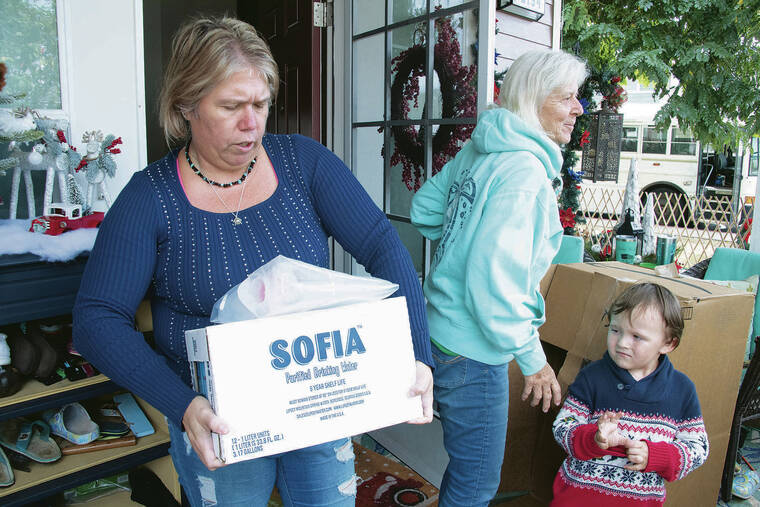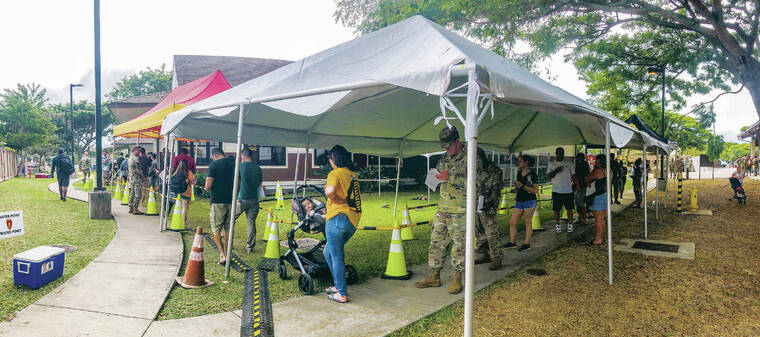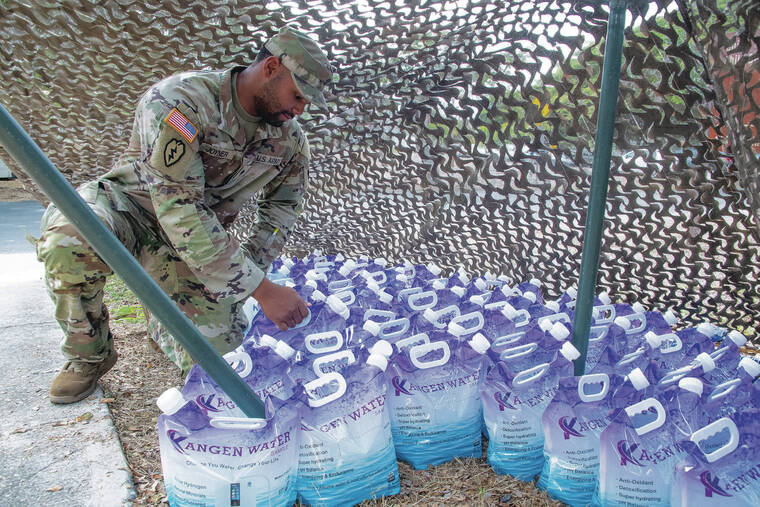Water samples taken by the Navy at its Red Hill drinking water well showed petroleum contamination in July, August and September, according to test results made publicly available by the state Department of Health last week. Some of the samples exceeded the state’s threshold for what is typically considered safe.
The Navy quietly shut down the Red Hill shaft on Nov. 28 as military families began lodging complaints that their tap water smelled like fuel or chemicals and that they feared it was making them sick. Since then, hundreds of households, as well as several schools, have reported that their water has had a fuel-like odor, odd sheen or bad taste.
Numerous residents have also reported skin rashes, nausea and vomiting, as well as sick pets.
The water sampling results raise questions about whether more should have been done earlier to protect the health of not only the military troops and their families who reside in military housing at Joint Base Pearl Harbor-Hickam, but hundreds of young schoolchildren and an unknown number of other residents and businesses who rely on the Navy’s water system.
“These reports demonstrate the Navy knew months ago that there was petroleum pollution in the water,” said Wayne Tanaka, director of the Hawaii Sierra Club. He said if the reports had been made available earlier, then “maybe more immediate action could have been taken and these families spared the horrific experience of drinking fuel-tainted water.”
>> RELATED: Navy says exposure to contaminated water not expected to have long-term health effects
>> RELATED: Worst-case scenario puts Oahu aquifer at risk
Rear Adm. Blake Converse announced Thursday evening that the Navy had concluded that its Red Hill shaft was indeed contaminated with petroleum, which is believed to have migrated into users’ tap water in recent days.
The Navy’s water system serves an estimated 93,000 people. The Honolulu Star-Advertiser has requested a detailed account of who is on the system from the Navy and the Health Department. DOH has said it doesn’t know and the Navy has not responded.
DOH did provide the newspaper with a list of the public schools on the Navy’s water system, which include six elementary campuses: Red Hill, Nimitz, Iroquois Point, Salt Lake, Pearl Harbor and Pearl Harbor Kai. Holy Family Catholic Academy and Aliamanu Child Development Center are also served by the system.
It’s not clear how many of those schools may have been affected by the current water contamination.
Water monitoring
After 27,000 gallons of fuel spilled from the Navy’s Red Hill Underground Fuel Facility in 2014, the U.S. Environmental Protection Agency and DOH required the Navy to conduct quarterly testing of the groundwater around the facility, which contains 20 massive underground fuel tanks located 2.5 miles from Pearl Harbor.
The Navy has been routinely testing its Red Hill drinking water shaft, as well as a series of monitoring wells that can help detect whether dangerous levels of fuel contamination are migrating toward drinking water wells.
After the Navy reported that hundreds of gallons of jet fuel had spilled from a pipeline at the Red Hill facility on May 6, state health officials say they pushed the Navy to ramp up testing to several times a week and now weekly.
But DOH claims it is has struggled to get the Navy to turn over the results, which the department says are typically ready in three to six weeks.
DOH said that on Nov. 24, the Navy finally provided it with four months of test results taken from samples collected in July through October, including the results showing petroleum contamination in the Red Hill shaft. DOH recently posted those results on its website Opens in a new tab and said it is still awaiting additional data from the Navy for September and October.
DOH didn’t respond to questions about the contamination detected in the test results at Red Hill shaft this summer. But Erwin Kawata, program administrator for the Honolulu Board of Water Supply, said the data shows petroleum chemicals associated with heavy oils and grease were found in water samples from the Red Hill shaft from July 8 to Sept. 29. Kawata pointed out that some of the results exceeded DOH’s drinking water toxicity level for total petroleum hydrocarbons.
“The BWS is very concerned about the levels detected and the lack of notice informing us of the results,” Kawata said by email. “We will be asking DOH to explain the notification process and if these results are related to the Joint Base Pearl Harbor-Hickam water problem that began on (Nov. 28).”
Kawata and Ernie Lau, manager and chief engineer of the Board of Water Supply, said that neither the Navy nor DOH had alerted them to the test results. They say they were made of aware of them Thursday by the Star-Advertiser.
The Board of Water Supply is now scrambling to protect its own nearby water well in Halawa that pulls water from the same aquifer as the Red Hill shaft after the Navy announced last week that it was the source of pollution. The Board of Water Supply on Friday shut down the Halawa well, which provides water to southern Oahu, as a precautionary measure and has urged residents in the meantime to conserve water.
The Navy didn’t respond to an interview request for this story. But Lydia Robertson, a spokeswoman for Navy Region Hawaii, said that DOH was notified of the petroleum levels in the Red Hill shaft in the first week of October.
“At the first indication of an exceedance the Navy immediately implemented daily sampling,” she said.
Robertson said that while the “elevated” readings were above the levels that would have required environmental action, they were below much more permissive standards set by DOH for contamination around Red Hill.
Missing test results
Both DOH and EPA, which regulate safe drinking water, said they have struggled to get the Navy to turn over test results in a timely manner. They say the Navy has cited a lack of available lab capacity for the delays.
“DOH has conveyed to the Navy on numerous occasions that its long turnaround times on monitoring well tests are unacceptable,” said Kaitlin Arita-Chang, a DOH spokeswoman, by email. She said some of the data from September and October is still missing.
Arita-Chang said the investigation to determine the source of contamination in the Navy’s drinking water system is ongoing and that DOH is “exploring several causes.”
DOH didn’t respond to questions about why it didn’t post the data until Thursday, even though it says the Navy provided it on Nov. 24.
U.S. Sen. Brian Schatz, D-Hawaii, said the lack of data sharing is troubling.
“The Navy, the DOH, the EPA, and the Board of Water Supply need to collect, analyze and share all data in real time with each other and more importantly the public,” Schatz said. “The fact that we can barely get the DOH and the Navy to stand together in a news conference does not inspire confidence, and it is emblematic of a dysfunctional relationship that has to be fixed immediately.”
DOH said it is also struggling to get the Navy to turn over recent test results and data relating to the current water contamination around Red Hill.
Kathleen Ho, DOH deputy director for environmental health, sent a letter Saturday to Rear Adm. Timothy Kott, commander of Navy Region Hawaii, demanding that the Navy immediately turn over a litany of information, including water test results, sampling plans, the name and address of every lab that is being used, the methodology for collecting samples and raw data directly provided by the labs.
Ho asked that the information be provided by Tuesday, if not immediately.
“If the DOH does not receive the requested records, the matter may be referred to the Hawaii State Department of Attorney General for further action,” wrote Ho.
In response, the Navy’s Robertson said in a statement late Saturday, “We have been sharing information and data with DOH, and they have made several site visits to discuss and observe the sampling. We are already providing the information that they are asking for in this letter. Another site visit is already scheduled for tomorrow. We continue to coordinate closely with DOH in all aspects of this issue.”
She added, “Additionally, we have invited them to our twice-a-day meetings. They have had extended discussions with our senior leaders as well.”








